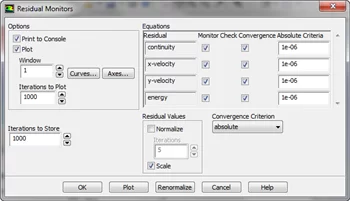Numerical Solution — Lesson 6
Solution Methods
In the Outline window, select Solution Methods to open the Solution Methods window. Under Spatial Discretization, ensure that the option for Flow is specified as Second Order Upwind. (Hint: If you don't see Flow, go back and ensure that you changed the solver from Pressure-based to Density-based under the General tab.)
Solution Controls
In the Outline window, select Solution Controls to open the Solution Controls window. (Note: In later versions, this is simply named Controls.) Ensure that the Courant Number is set to 5.0.
The Courant number can be considered a non-dimensionalized timestep. The density-based solver obtains the steady-state solution by starting with the initial guess and marching in pseudo-time until convergence is obtained. The Courant number controls the time step the solver uses. The larger it is, the faster the solution will converge but it will not be very stable and can diverge. The smaller it is, the slower it is to reach convergence but the solution is much more stable.
Monitors
In the Outline window, click Monitors to open the Monitors outline. In the Monitors outline, double-click Residuals. This will open the Residual Monitors window. We want to change the convergence criteria for our solution. Under Equations and to the right of Continuity, change the Absolute Criteria to 1e-6. Repeat for x-velocity, y-velocity, and energy, then press OK.

Solution Initialization
In the Outline window, select Solution Initialization. (Note: In later versions, this is simply named Initialization.) We need to make an "Initial Guess" of the solution so Fluent can iterate to find the final solution. In the Solution Initialization window, select Standard Initialization, then under Compute from, select farfield from the drop-down box. Check to see that the values that are generated match the values that we input, then press Initialize.
Run Calculation
In the Outline window, select Run Calculation. Change the Number of Iterations to 4000. Double-click Calculate to run the calculation. It should take a few minutes to solve. After the calculation is complete, save the project. Do not close Fluent.
If your solution is having convergence issues, try to use Third Order MUSCL under Solution Methods > Spatial Discretization.
Third Order MUSCL helps to converge the solution, especially if you are seeing many oscillations between a few values in your residuals.
